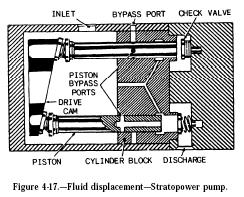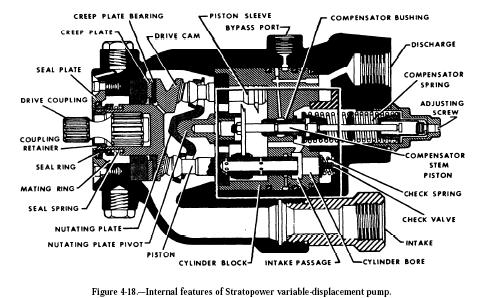Another type of axial piston pump, sometimes referred to as an in-line pump, is commonly referred to as a Stratopower pump. This pump is available in either the fixed-displacement type or the variable-displacement type.
Two major functions are performed by the internal parts of the fixed-displacement Stratopower pump. These functions are mechanical drive and fluid displacement.
The mechanical drive mechanism is shown in figure 4-16. In this type of pump, the pistons and block do not rotate. Piston motion is caused by rotating the drive cam displacing each piston the full height of the drive cam during each revolution of the shaft. The ends of the pistons are attached to a wobble plate supported by a freed center pivot and are held inconstant contact with the cam face. As the high side of the rotating drive cam depresses one side of the wobble plate, the other side of the wobble plate is withdrawn an equal amount, moving the pistons with it. The two creep plates are provided to decrease wear on the revolving cam.
A schematic diagram of the displacement of fluid is shown in figure 4-17. Fluid is displaced by axial motion of the pistons. As each piston advances in its respective cylinder block bore, pressure opens the check valve and a quantity of fluid is forced past it. Combined back pressure and check valve spring tension close the check valve when the piston advances to its foremost position. The low-pressure area occurring in the cylinder during the piston return causes fluid to flow from the reservoir into the cylinder.
The internal features of the variable displacement Stratopower pump are illustrated in figure 4-18. This pump operates similarly to the fixed-displacement Stratopower pump; however, this pump provides the additional function of automatically varying the volume output.
This function is controlled by the pressure in the hydraulic system. For example, let us take a pump rated at 3000 psi, and providing flow to a 3000 psi system. As system pressure approaches, say 2850 psi, the pump begins to unload (deliver less flow to the system) and is fully unloaded (zero flow) at 3000 psi.
The pressure regulation and flow are controlled by internal bypasses that automatically djust fluid delivery to system demands.
The bypass system is provided to supply self-lubrication, particularly when the pump is in nonflow operation. The ring of bypass holes in the pistons are aligned with the bypass passage each time a piston reaches the very end of its forward travel. This pumps a small quantity of fluid out of the bypass passage back to the supply reservoir and provides a constant changing of fluid in the pump. The bypass is designed to pump against a considerable back pressure for use with pressurized reservoirs.


